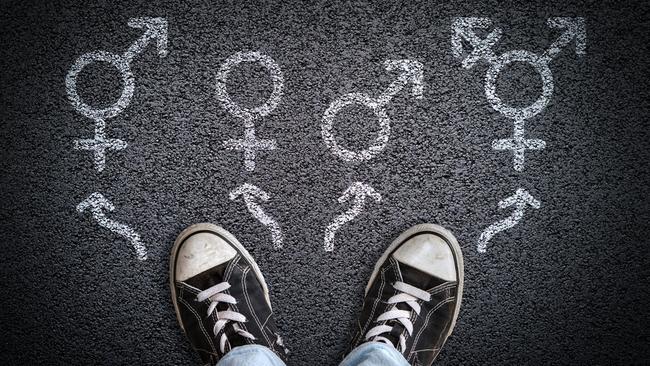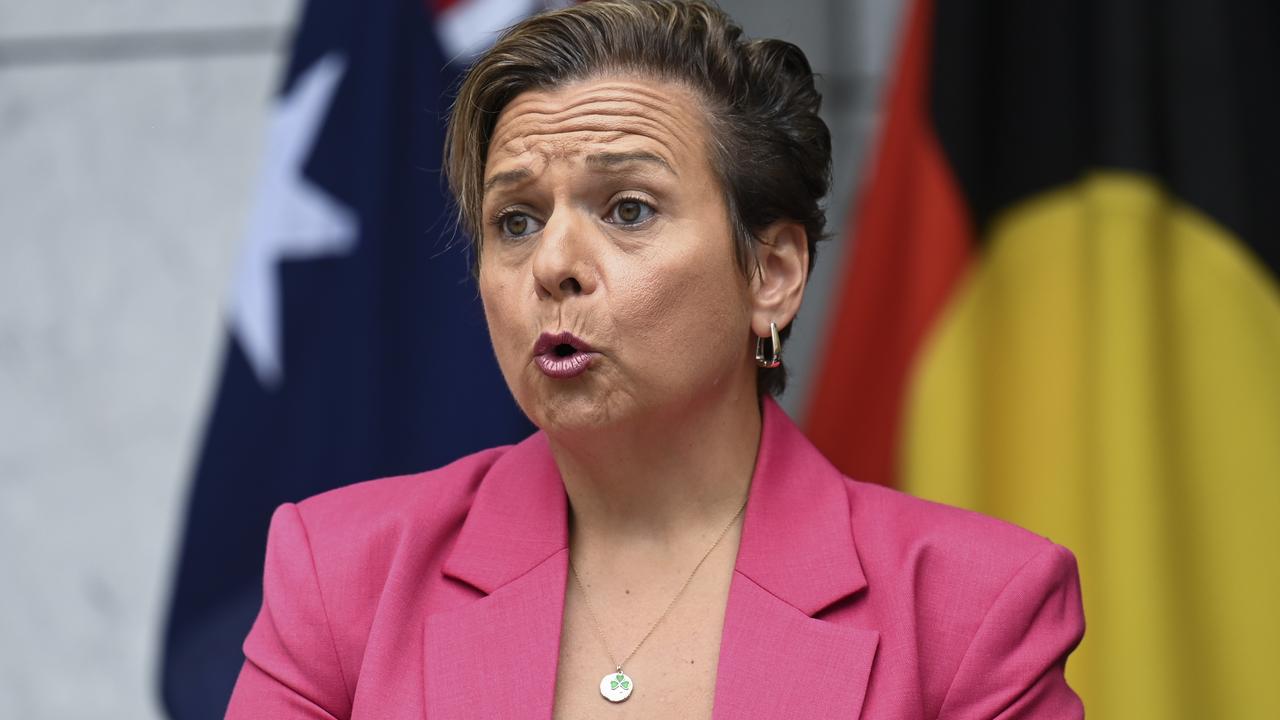Reason lost to suicide in trans debate
Most people don’t know it but there is an anguished global debate over the medicalised bodies of teens and children who identify as trans.

“I realised I had been fantasising about surgery non-stop, real scary,” Lilian says, casting her mind back. Now she is 33 and a free-thinking lesbian, although she took the precaution of riding her bike to a remote location for this interview about transgender taboos. In her late 20s, she was living with friends who also didn’t fit gender norms and the common wisdom was “listen to the experiences of trans people”.
This meant “a lot of YouTube videos, a lot of trans timelines”, until she hit upon one person who seemed a soulmate with a similar background of mental health problems, only happier and on male hormones. Suddenly, Lilian felt she too must be a trans man.
Most people don’t know it but there is an anguished global debate with real momentum — and vitriolic pushback — over the medicalised bodies of thousands of teenagers and children who identify as trans. In affluent cities with advanced healthcare, there are discreet but growing networks of clinicians, parents and thoughtful outsiders alarmed about life-changing medical interventions for children as young as 10 who believe they are “born in the wrong body”.
Many of those with expertise will not risk job or reputation by speaking out. They have seen others put in the social media stocks as “hateful transphobes”, as if only advocates for the dominant pro-trans “affirmative” model of treatment are allowed concern for these troubled teens and children.
Nobody doubts the vulnerability of trans-identifying youth, nor the pressure on gender clinicians facing an explosion of complex, difficult patients. Clinics confront ethical dilemmas: the teen refused hormones may buy them on the black market, and who can predict which threats of self-harm will be acted upon? Still, critics believe questions must be asked, for the sake of child welfare.
Lowering the bar?
With debate cut short by identity politics and dramatic suicide claims, have standards of evidence and care been compromised for an already at-risk group too young to understand the lifelong implications? “We want the best for our children but we need this to be from a position of evidence-based, not experimental, medicine,” says “Mrs A”, the anonymous mother who is threatening London’s Tavistock gender clinic with litigation to stop her 15-year-old autistic daughter being medicalised as a default fix for what seems “gender confusion”. As for Lilian, something held her back from full immersion in trans orthodoxy. She sought out stories of “detransitioners” who reclaim their biological sex and feminists branded “transphobic” for quoting the dictionary definition of a woman as an adult human female. These critical viewpoints were liberating.
Trans closet
She is acutely aware how fear of suicide drives the transgender narrative. It’s used, she says, as “emotional blackmail to show why we should capitulate with every single demand around trans rights”. This ignores the trauma of detransitioners. An unknown number of these are young women who come to believe they were always lesbians, just hidden in a trans male closet. The detransitioners’ movement testifies to a life beyond pronouns and hormones.
By trial and error, they search for less invasive ways to cope with their problems — including gender dysphoria, the severe distress with one’s body that is filling hospital clinics with children and teens. Lilian says: “I really feel that transgender people, and those who lobby on their behalf, should be over the moon about (detransitioners) because it means it’s not a death sentence for all these trans people if they don’t transition.”
But detransitioners are vilified. “It makes me really angry, I despair for the state of things with this political climate,” Lilian says. She recalls one LGBT youth counsellor. “This person was saying, ‘Trans kids come to me, they’re so brilliant, but they’re so disturbed. And of course they’re depressed: everyone’s misgendering them (not using their new pronouns) all the time, and their parents think they’re autistic.’
“And in my head — because I know I can’t say any of this stuff — I’m like: ‘Well, are you screening these young people for autism or are you just going to accuse their parents of being hateful towards transgender people?’ ”
Risky talk
Also troubling is the activist mantra that kids will kill themselves if the trans project encounters any obstacle, personal or political. Lillian says: “I don’t understand why this one mental health condition is the exception to international best practice around how we talk about suicide.” Some suicide appears contagious, hence the well-known advice: don’t harp on the risk for a specific group, don’t imply taking your life is a default option, don’t catastrophise setbacks, don’t oversimplify the causes of suicide. Activists rediscover the risk of suicide contagion when they misrepresent media coverage that questions their narrative.
In April, ABC News told the story of Lottie, 9, who was born a boy but came out as a trans girl at the age of four. After some resistance, her parents gave in. The article sets up a dialogue between them and paediatrician Michelle Telfer, Australia’s best-known advocate for the “affirmative” model enabling treatment from puberty blockers through cross-sex hormones to surgery. She acknowledges worries about kids changing minds. “My answer to that is that we need to think about the risks of not intervening,” she said. “Because the risks of not providing support are that half of them will try to end their life.”
On cue, Lottie’s mother Karen tells the journalist: “One in two of these kids will try and kill themselves. I can’t do that to my kid, I can’t condemn my child to that.”
At the Royal Children’s Hospital Melbourne, where Telfer runs the country’s busiest youth gender clinic, referrals have risen from two in 2008 to 228 last year. In 2015, Victoria’s Andrews government gave the clinic a special injection of $6m to shorten the waiting list — which Telfer says “can literally be a killer”. Equality Minister Martin Foley declared: “This clinic saves lives.” The Weekend Australian does not dispute that Telfer genuinely believes “affirmation” and sometimes medical transition is vital for the mental health of her young patients. She and the hospital did not reply to a request for an interview or detailed questions.
It’s not just in major hospitals that fear of suicide is at work. It helped throw open women’s cricket to biological males and it’s been used to rebuke Scott Morrison. Last month, 19-year-old Georgie Stone, the first trans character in the TV drama Neighbours and the articulate ambassador for the mental health agency Headspace, suggested the Prime Minister’s tweeted disapproval of “gender whisperers” in schools was the kind of thing that made the suicide statistics “so horrible”. The PM’s reply lamented youth suicide but pointedly linked it to “the pressures of identity politics”.
The go-to statistic is that 48 per cent of trans youth have attempted suicide. It’s quoted as a prediction and has quasi-official status, as part of Telfer’s heavily promoted 2018 “Australian standards” for care, which says that withholding treatment from trans youth is not “a neutral option” as it may increase suicidality — suicidal ideas, plans and attempts.
This 48 per cent figure — reported as “staggering” by ABC News — comes from the 2017 Trans Pathways study of the Telethon Kids Institute in Perth. Before this, Telfer quoted a 28 per cent figure for attempted suicide by “gender questioning youth” from a 2010 survey called Writing Themselves in 3.
That survey is also cited in Telfer’s clinical guideline, but not for its lower suicide risk. Asked about the discrepancy, institute researcher Ashleigh Lin says both figures are “very high (and) both indicate a significant need for mental health support”.
There has been an atypical surge in teenagers, mostly girls, suddenly declaring trans status, and social media seems an obvious suspect. Telfer dismisses the idea of trans as a trend and says the rise in numbers simply reflects society becoming more inclusive and informed about a natural variation in gender. But if this is so, shouldn’t transphobia and suicide risk be falling? Unless years of talking up self-harm has primed trans youth to report suicidality.
Or maybe nobody really knows the attempted suicide rate or the trend. News reports skip the methodology but, like other overseas studies favoured by activists, Trans Pathways and Writing Themselves in 3 are anonymous online surveys with a “convenience sample” — whoever heard about it via mental health agencies, social media or trans groups.
So, the results may say something about those individuals who haphazardly formed a group by taking the survey but nothing credible about suicidality in the trans youth or gender questioning population of Australia. “You can’t get a representative sample (with self-selected participants). It’s going to be highly biased and usually that means the estimate is going to be way off,” says Hacsi Horvath, an American who has a special interest in the subject as an expert in epidemiology and research methods but also as someone who lived for 13 years as a trans woman and took oestrogen. He wants to spare kids the regret and harm he lives with.
Horvath says activists commonly misuse convenience samples to inflate suicidality. He points to an unusual 2017 survey where a government contract required a more rigorous design, including a representative sample of California’s adolescents, as well as trained interviewers who tested suicidality claims over the phone. Only 3 per cent of “highly gender non-conforming” kids reported attempted suicide.
Not so unique
Horvath’s hunch is that suicide risk will be roughly similar for trans youth (under various labels), gay kids, those with mental illness and bullying victims. The fact these are overlapping categories is a key reason for concern about the affirmative model’s pro-trans bias and the narrative that trans kids are uniquely suicidal. “Kids are being hyped into believing suicidality is a normal state,” Horvath says. Detransitioners report kids being coached online in how to use suicide statistics to pressure parents.
“The likelihood of such contamination (of surveys) makes the use of self-report data on suicidality even more problematic than it usually is,” says psychologist Ray Blanchard, a leading international sex researcher. “The combination of a self-selected sample and self-reported data makes any statistics on suicidality virtually useless.”
That new, worldwide group of teenage dysphoria patients since the 2000s typically has no history of gender confusion but presents with pre-existing issues including mental health problems, autism, repressed same-sex attraction, sex abuse or family trauma. A level of suicidality above the norm is not a surprise. But which pathology gets attention? Is dysphoria a cause or an effect? What should the treatment be? Critics of the affirmation model fear a hurried fixation with gender to the exclusion of all else.
It doesn’t help when parents hesitating on the brink of risky treatment are asked, “Do you want a live son or a dead daughter?”, or vice versa. Canadian psychologist Ken Zucker, a world expert on dysphoria, scorns this pressure tactic as “pure dogma”.
“We know essentially nothing about completed suicides in people with gender dysphoria,” he says. “If you are depressed, your suicidality risk is going to be elevated, but you see that in kids who are depressed but don’t have gender dysphoria. The idea that adolescents with gender dysphoria are at a higher risk of suicide per se is dogma — and I think it’s wrong.”
Blanchard says a proper study of suicidality would compare the progress of dysphoric kids with a control group referred to the same clinic for other psychiatric problems. Zucker suggests using long waiting lists at clinics as a quasi-control to study how many of these new teenage patients recover from their “rapid onset” dysphoria without treatment. In the old days, 60-80 per cent of early onset kids grew out of dysphoria and embraced their bodies, many emerging as gay or bisexual adults.
Goodbye nuance
Dana, a 30-something Sydney transsexual who has undergone the full medical transition, worries that troubled kids may not get the careful assessment they deserve at today’s gender clinics. She watches with distaste as overnight activists play the “suicide card” when pushing a rights agenda for trans status based on nothing more than self-identification.
“Nuance has been thrown out the window,” she says. “There’s feeling suicidal, having suicidal thoughts, having suicidal ideation, there are the attempts, and then there’s the successful execution of suicide — where’s the nuance? No, we’ll just put it under the 48 per cent.” She points out that such an eye-catching headline statistic doesn’t distinguish suicide risk before or after hormones, with or without dysphoria, or post-operative transsexuals from “non-binary” kids content with pronouns and purple hair.
“Are there genuine mental health issues for these sub-groups — maybe there are, or maybe it’s politically riding on the coat-tails to further a range of issues like self-identification,” she says.
This is not risk-free. “The more you engage in negative talk, it obviously has some sort of impact on your mental health. The 48 per cent, it’s talked about as a thing that’s going to happen to 48 per cent — such a large number is not very good for morale, is it?”
If you or someone you know may be at risk of suicide call Lifeline
on 13 11 14 or the Suicide Call Back Service on 1300 659 467,
or see a doctor


